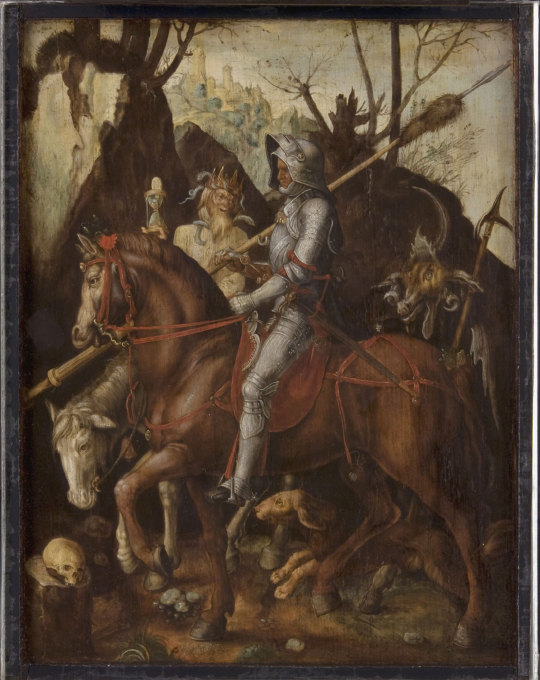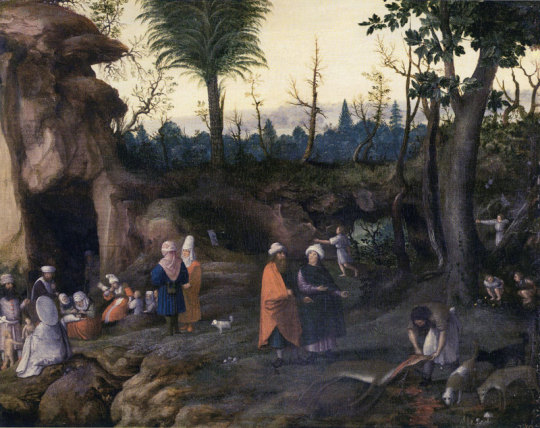#cornelis van dalem
Text

A Knight, Death, and the Devil, variously attributed to Cornelis van Dalem (ca. 1528-1573) or Jacob Züberlein (1556-1607)
#art#art history#Cornelis van Dalem#Jacob Züberlein#allegory#allegorical art#knights#knighthood#Northern Renaissance#German Renaissance#German art#16th century art#oil on panel#Philadelphia Museum of Art
318 notes
·
View notes
Text

A Knight, Death, and the Devil
Remake by Cornelis van Dalem, after the engraving by Albrecht Dürer
The famous engraving by Albrecht Dürer represents the epiphany of the man Heideggerianly thrown into the world, whose destiny is, humanistically, to be "faber fortunae suae", regardless of any obstacle, including the apparently impassable one of evil, that is, the devil, and of time, or of decay and death.
#knight#death#devil#art#cornelis van dalem#albrecht dürer#symbolist#symbolism#esoteric#medieval#knights#middle ages#chivalry#history#europe#european#landscape#spiritual#salvation#noble steed#armour#dog#faith#quest#nuremberg#religious#religion#christian#hourglass#salamander
231 notes
·
View notes
Text

The Legend of the Baker of Eeklo
Cornelis van Dalem
1550
21 notes
·
View notes
Photo

Cornelis van Dalem, Jan van Wechelen - Landscape with nomads -
oil on canvas, height: 29.5 cm (11.6 in); width: 35.5 cm (13.9 in)
The Staatliche Kunsthalle (State Art Gallery) is an art museum in Karlsruhe, Germany.
Cornelis van Dalem (1530/35 – 1573 or 1576) was a Flemish painter and draughtsman active in Antwerp in the middle of the 16th century and an important contributor to the development of landscape art in the Low Countries. Van Dalem introduced into landscape painting new themes, which he derived from his humanistic education, and searched for new ways of representing his themes.
Jan van Wechelen or Hans van Wechelen (c. 1530 – 1570) was a Flemish painter and draughtsman active in Antwerp in the middle of the 16th century known for his landscapes, biblical subjects and genre scenes.
Only a few works by Jan van Wechelen are known to exist as most of his oeuvre was destroyed by war and the Iconoclasm of the 16th century. The majority of these are landscapes and religious scenes. His oeuvre also includes a few genres scenes and an architectural painting of a church interior. The artist’s work enjoyed an excellent reputation at the beginning of the 17th century and was collected by Rubens as well as the prominent art collectors Cornelis van der Geest and Pieter Stevens.
Jan van Wechelen collaborated regularly with fellow Antwerp artist Cornelis van Dalem. Van Wechelen was a gifted staffage painter and his dignified figures are regarded as well suited to van Dalem’s landscapes. At least three such collaborations between the two artists are suspected. This includes a Landscape with nomads (also known as Landscape with gypsies at the Staatliche Kunsthalle Karlsruhe. This painting likely represents a family of gypsies as a seated woman wears the distinctive oval white hat which was a common indicator for a gypsy woman in 16th century Flemish paintings.
35 notes
·
View notes
Photo

Attributed to Cornelis van Dalem after an engraving by Albrecht Dürer - A Knight, Death, and the Devil (between 1545 and 1573)
56 notes
·
View notes
Photo

Cornelis van Dalem (Flemish, 1530/35–1573 or 1576), Landscape with Farm, 1564, oil on panel, 103.2 x 127.7 cm, Munich, Alte Pinakothek
#Cornelis van Dalem#van Dalem#flemish artists#artistes flamands#arbre#tree#peinture#painting#huile sur panneau#oil on panel#landscape artistes#artistes paysagistes
90 notes
·
View notes
Photo

Attributed to Cornelis van Dalem - A Knight, Death, and the Devil. 1545 - 1573
47 notes
·
View notes
Photo

Circle of Cornelis van Dalem (c. 1530-1576) and Jan van Wechelen (c. 1530-1570) - The Legend of the Baker of Eeklo
20 notes
·
View notes
Photo

A SONG IN THE DESERT (Paul Celan, 1952)
A garland was wound of blackening leaves in the region of Acra.
I reined a dark stallion around and stabbed at Death my dagger.
I drank from wooden vessels the ashes of the fountains of Acra
and lowered my visor and charged straight against the ruins of Heaven.
Dead are the angels and blind went the Lord in the region of Acra,
there’s no one in the night who will guard in my stead over those who here went to their rest.
The moon was hacked to pieces, the blossom of the region of Acra:
so the hands shall blossom like the thorn in their rings all of rust.
And so at the last I must bow for the kiss when they pray there in Acra
Ill-wrought was the armor of night, through the greaves I see the blood seep!
So I have become now their smiling brother, the iron kerûbh of Acra.
I still pronounce the name, and still on my cheek feel the blazing.
*Knight, Death and the Devil (det.). Cornelis van Dalem, after the engraving (1513) by Albrecht Dürer. Philadelphia Museum of Art • via Bibliothèque Infernale on FB
30 notes
·
View notes
Photo

Church Interior with Christ Preaching to a Crowd by Cornelis van Dalem, Museum of the Netherlands
Kerkinterieur met Christus die zittend predikt tot een menigte. Op de voorgrond jagen roomse geestelijken enige kinderen weg.
12 notes
·
View notes
Photo

Cornelis van Dalem, Paysage avec une métairie, 1564. Munich, Alte Pinakothek.
1 note
·
View note
Photo

Flemish painter (copy after Cornelis van Dalem and Jan van Wechelen), The Legend of the Baker of Eeklo, first quarter of the 17th century, oil on panel, 21 x 32 cm, Turin, Palazzo Reale, Galleria Sabauda
This painting depicts the fascinating legend of the baker of Eeklo, situated between Bruges and Ghent in Flanders. Around 1540 the legend first appeared, involving a baker that would “re-bake” human heads. Men and women unhappy with the characteristics of their (lovers’) heads would visit the bakery. While their chopped off heads were rubbed with a wondrous fluid and baked in the oven, a cabbage was placed on top of their necks to stop the bleeding. In the process the heads changed according to the wishes of those who supplied them. Overheating resulted in a hothead!
An explanation is given in a print dating from ca. 1700, nowadays kept at the Rijksmuseum Amsterdam, and a German variant from ca. 1650. The legend even has its own Iconclass code: 31B812 baking the head, e.g. by the baker of Eeclo (heads temporarily replaced by cabbages). Several copies of a presumably lost original by Van Dalem and Van Wechelen exist, such as the one currently on display in Turin, and other versions in collections of the Rijksmuseum, the Museum der bildenden Künste Leipzig, a much larger privately owned panel, and a detailed reproduction on copper.
0 notes
Photo

Cornelis van Dalem (attr.) and Jan van Wechelen (attr.) - Church interior with Christ preaching to a crowd -
oil on panel, height: 59 cm (23.2 in); width: 93 cm (36.6 in)
Rijksmuseum, amsterdam. the Netherlands
Cornelis van Dalem (1530/35 – 1573 or 1576) was a Flemish painter and draughtsman active in Antwerp in the middle of the 16th century and an important contributor to the development of landscape art in the Low Countries. Van Dalem introduced into landscape painting new themes, which he derived from his humanistic education, and searched for new ways of representing his themes.
Jan van Wechelen or Hans van Wechelen (c. 1530 – 1570) was a Flemish painter and draughtsman active in Antwerp in the middle of the 16th century known for his landscapes, biblical subjects and genre scenes.
A composition entitled Church interior with Christ preaching to a crowd (Rijksmuseum) is attributed to a collaboration between van Wechelen and van Dalem. It shows a large church interior with a crowd of people in contemporary as well as foreign dress who are listening to Jesus Christ who is preaching while seated near a column. The interior of the church is quite barren and the only decorations seen are some sculptures high on the columns. Various scenes are depicted in the interior of the church such as priests chasing away children, a man with a walking stick and a dog who is accosted by a man in thorn clothes (a beggar?), some dogs sniffing each other, a couple flirting, a man with a shovel etc.
Van Dalem, his collaborator on this composition, was suspected of being a Protestant and possibly the composition contains criticism of the Catholic Church. By placing a preaching Jesus amidst modern church architecture and a contemporary crowd the composition should possibly also be read against the background of the iconoclasm of the Beeldenstorm, which had caused a reflection on the role of religious art in the Low Countries. The attack on sculptures and paintings had placed the entire church interior under discussion. Finding answers to questions such as what a church should be, which type of architecture was suitable and how it should be embellished had become urgent. Contemporary religious practice was compared with the words and deeds of Christ and his apostles and the past and the future of religion, its temples and its rites were under scrutiny.
15 notes
·
View notes
